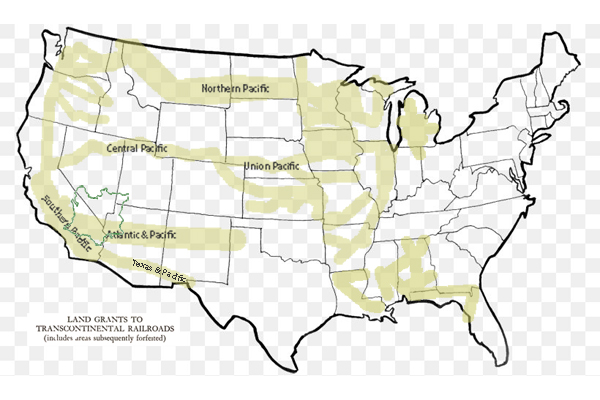Railroads
Chronology of Events
The 1785 Land Ordinance provided that all federal land would be surveyed into townships six miles square. Townships are subdivided into 36 one-mile-square sections. Sections can be further subdivided into quarter sections, quarter-quarter sections, or irregular government lots. Each township is identified with a township and range designation. Township designations indicate the location north or south of the baseline, and range designations indicate east or west of the Principal Meridian. A meridian is an imaginary line running north to south.

1861 Central Pacific Railroad is incorporated.
1862 President Abraham Lincoln signed the Pacific Railway Act, a law that authorizes the federal government to give land grants and loans to aid construction of the Central Pacific Railroad as the Western part of the Transcontinental Railroad and the Union Pacific as the Eastern part.
1863 Central Pacific begins construction at Sacramento.
1864 The United States Congress passes the Pacific Railway Act of 1864, which doubles the land grant to 20 alternate sections per mile, with a 20 mile checkerboard corridor on each side of the right-of-way.
1865 The Southern Pacific Railroad Company is incorporated.
1865 Central Pacific Railroad establishes a Land Department in Sacramento. Benjamin B. Redding, former mayor of Sacramento, was chosen to lead to design and manage the new organization.
1866 The Pacific Railway Act is amended to allow a railroad to select lands outside of the land grant area in exchange for unavailable land grant land.
1866 The federal government gives Southern Pacific Railroad a land grant to complete the western section of the Atlantic & Pacific line through California via Mojave to Needles.
1867 First land patent is issued to the Central Pacific Railroad by the federal government.
1868 September 25: The Central Pacific Railway owners acquire control of the Southern Pacific Railroad.
1869 The California & Oregon Railroad receives a federal land grant to build a line northward from Davis to connect to the Oregon & California Railroad at the California and Oregon border.
1869 The Central Pacific Railroad begins operating the California & Oregon Railroad.
1869 The Golden Spike ceremony held at Promontory, Utah, marks the completion of the transcontinental railroad between Sacramento, California and Omaha, Nebraska.
1870 California & Oregon Railroad is consolidated with the Central Pacific Railroad, and becomes a branch line of the Central Pacific Railroad.
1871 The federal government gives the Southern Pacific Railroad land grants and loans, allowing it to build to meet the Texas & Pacific at Yuma, California and build from Los Angeles to Colton, California.
1875 The Southern Pacific Railroad opens a land agency in San Francisco. 1876 Jerome Madden, Benjamin Redding’s assistant, became the land agent for Southern Pacific.
1886 Southern Pacific Company assumes control of the Oregon & California Railroad.
1899 The Central Pacific Railroad is reorganized as the Central Pacific Railway in order to pay off its federal debt.
1912 The Southern Pacific Company transfers some of its remaining land assets to Southern Pacific Land Company.
1916 Oregon & California grant lands are returned to the Federal Government.
1927 Southern Pacific purchases the Oregon & California Railroad.
1984 The Southern Pacific Company merges with Santa Fe Industries, parent company of the Atchison, Topeka & Santa Fe Railway, to form Santa Fe Southern Pacific Corporation (SPSF).
1985 The Interstate Commerce Commission (ICC) denies permission for the railroad operations to merge.
1986 Appeal of the ICC ruling fails.
1986 The renamed holding company, the Santa Fe Pacific Corporation, retains all of the non-rail interests of both companies except one. All of the Southern Pacific Railroad California real estate holdings are transferred to a new holding company, Catellus Development Corporation.

1996 The Southern Pacific Railroad is acquired by Union Pacific Railroad and its operations cease.
2005 Catellus Development Corporation is merged into ProLogis, another land development company based in San Francisco. ProLogis remains one of the largest real estate holders in California.
California State Railroad Museum Library and Archives
https://oac.cdlib.org/institutions/California+State+Railroad+Museum+Library+and+Archives